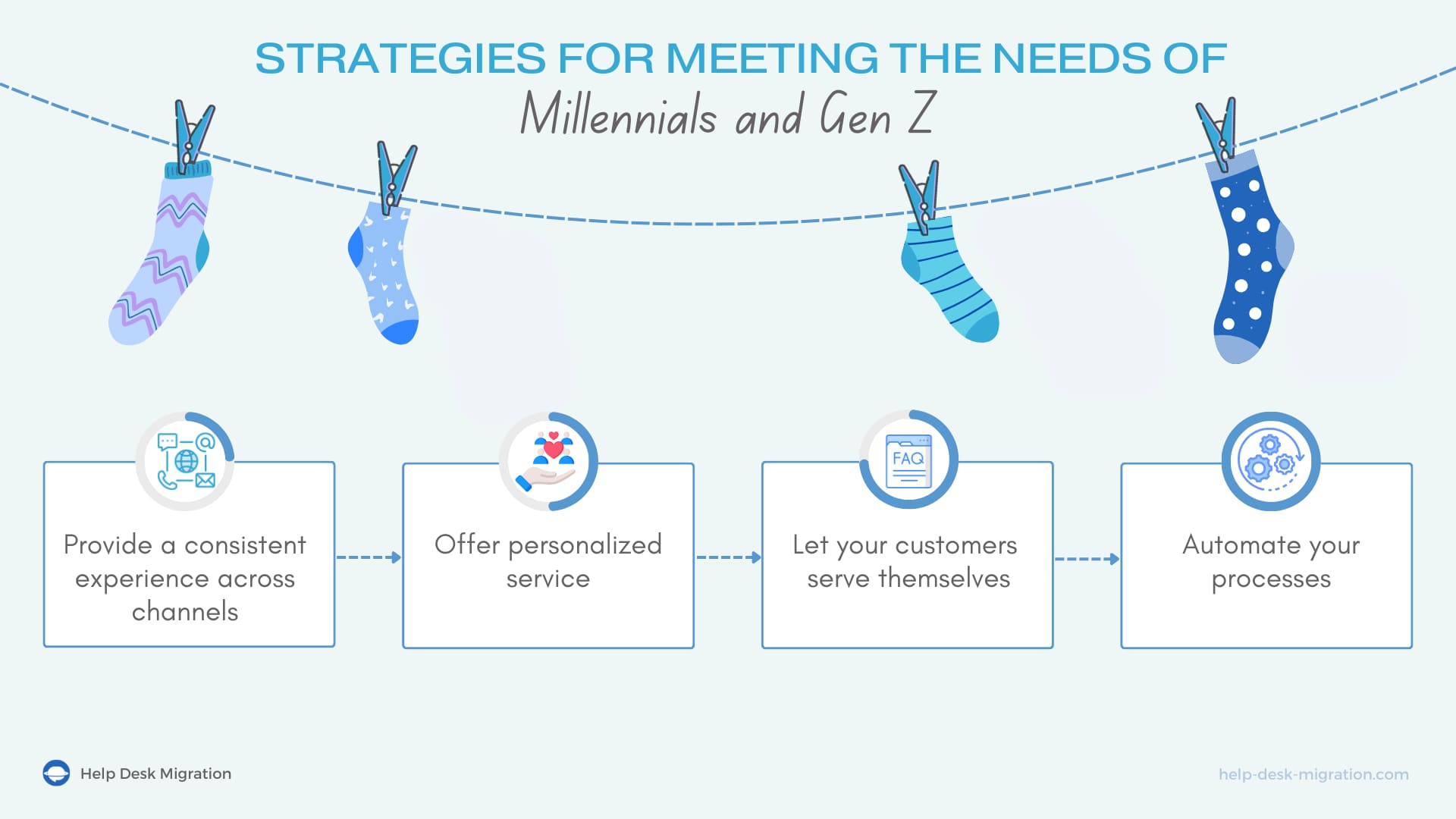Neglecting the generational differences among your customers can hinder your business. Abercrombie & Fitch — a 120-year-old brand once favored by Franklin D. Roosevelt and Ernest Hemingway — learned this lesson the hard way when it became known as America's most hated brand in 2016. The retailer was slow to adapt its exclusive image, which targeted "cool" and "attractive" youth, to meet the younger generation's demand for inclusivity and sustainability.
While Millennials still dominate the market, Gen Z is on the verge of reaching adulthood over the next decade and becoming the largest consumer demographic in history. Unfortunately, the Millennials vs Gen Z distinctions extend beyond the answer to the question, “Who is older, Millennials or Gen Z?” and the preferred sock length. To avoid Abercrombie & Fitch’s fate, businesses must adapt every aspect of their operations, including customer service.
In this article, we will guide you on how to tailor your support strategies for this younger generation while still addressing the needs of the current customers. But first things first, who are Millennials and Gen Z? Let’s start with the basic breakdown of Millennials vs Gen Z characteristics.
Who are Millennials, and What Are Their Key Characteristics
Millennials, or Gen Y, are a demographic cohort that follows Gen X and precedes Gen Z.
There is a lot of dispute around where Millennials end and Gen Zers begin. The Pew Research Center defines anyone born between 1981 and 1996 as a Millennial, using the events of 9/11 as the benchmark. If you remember the Twin Tower attack, you are a Millennial.
Aside from being shaped by this tragic event, most Millennials entered adulthood in the aftermath of 2008’s economic crisis. They are the first truly diverse group, both racially and ethnically, in the U.S. nation’s history (Gen Zers do have the upper hand here, but we’ll get to that later).
As of 2024, this is also the largest demographic. There are more than 72 million Millennials in the U.S. alone, constituting around 22% of the country’s population. How do you spot them in the wild? There are some key characteristics Millennials possess.
Digital pioneers
Millennials are known to be pioneers of the tech era. While the landline was an integral part of their childhood, they witnessed the rise of the internet, smartphones, instant messaging, and social media.
The technology-driven background has influenced their lifestyle choices significantly. For example, Millennials prefer shopping online.
Research reveals that 78% of Gen Y consider a brand’s shopping app or website critical for driving loyalty. Besides, 67% made a purchase through a social media post in 2022.
Economically challenged
Many Millennials entered the workforce during the Great Recession of 2008, which has affected their economic stability and earning potential. Burdened by substantial student loans and other financial constraints, they tend to delay traditional life milestones, such as marriage, kids, or buying a home.
Impulse-driven shoppers
Despite being one of the poorest generations, Millennials aren’t thrifty. With their “live in the moment” mindset, they prefer making frequent, insignificant, impulse-driven purchases.
In addition, Millennials gravitate toward luxury brands more than other generations and were considered the biggest e-commerce spenders of 2023. They also prioritize experiences over material possessions.
Socially aware
Known for being socially conscious and value-driven, this generation advocates for issues like climate change and social justice. Addressing climate change is a top concern for 33% of them.
Millennials are also highly concerned with ethics both as consumers and employees: it’s crucial for 73% of Millennials that the brand they’re loyal to has a purpose.
Demanding employees
In the workplace, Millennials are an ambitious group. They need to be heard, prefer working in a group, and strive to seek opportunities for professional development. Loyalty to an employer isn’t their strong suit.
At the same time, the Great Recession taught them you can lose everything in a moment. That’s why this generation values flexibility and work-life balance.
Loyal customers
While Millennials don’t stick with workplaces, they do with brands: over 83% of customers from this group are ready to pay more for their favorite brands. Even if the nearest location of their favorite brand is closed, they are ready to take their time and travel to the other one.
Gen Y appreciates when brands do their best to cherish relationships with them: to a greater extent than other generations, Millennials love loyalty programs and special offers.
This cohort is often grouped with Gen Z, their successors, under the label of “younger generation,” which is too generalized. So, what is the difference between Millennials and Gen Z?
Who are Gen Zers, and What Are Their Key Characteristics
Gen Z, or Zoomers, is loosely defined as anyone born between 1997 and 2012. With over 69 million Zoomers in the U.S. as of 2024, they’re set to become the leading generation in the workplace and consumer markets in a few years. They are also the most racially and ethnically diverse generation in U.S. history, with over half of this group belonging to the multicultural population.
As for the main difference between Millennials and Gen Z, the latter are considered the first digital natives. Social media, constant connectivity, and on-demand entertainment were integral to their childhood and adolescence.
Despite growing up surrounded by devices, some of Zoomers' early-life experiences were tougher than those of Millennials. While they don't remember the September 11 attacks, they grew up in the context of heightened security concerns. Gen Zers witnessed their parents losing hard-earned assets during the Great Recession and experienced disruptions in education and social life due to the COVID-19 pandemic.
Let’s look at some more characteristics of Zoomers that highlight the key differences between Gen Z and Millennials.
Digital natives
Gen Zers don’t remember a time without a fast internet connection and smartphones. Growing up with social media, 60% of Gen Z use these platforms as search engines. This generation is also more likely than its predecessors to purchase something after seeing an influencer’s post about it.
Overall, 60% of Gen Zers follow an online creator, against 42% of Millennials.
Community-driven
Having spent their adolescence and early adulthood in the isolation of the COVID-19 quarantine, Gen Zers need their people more than other generations, as McKinsey reveals.
One of the key factors that keep Gen Zers coming back to the brand is the ability to connect with other people who love this brand.
Pragmatic
Gen Z (52%) worry about their financial security and stability more than double compared to older generations. They are known for being savvy and setting clear financial goals.
Predictably, they put price over product quality, product availability, and purchase options.
Educated
While Millennials question the value of their college degrees and student debt, Gen Z actively explores alternative education paths like on-demand learning and employer-provided training.
At the same time, Gen Z is the most educated generation, with 57% of Zoomers having enrolled in college at the ages of 18-21.
Authentic
Gen Zers love authenticity and dislike everything glossy and Instagrammable. This explains their gravitation towards TikTok, where influencer content is less polished than on Instagram.
No wonder Doja Cat harvested millions of likes with her “totally unpolished” advertisement of the bedazzled JBL speaker.
More socially conscious
Zoomers are highly aware of social issues, including climate change. And this is where they aren’t thrifty: 50% are ready to give 25-75% extra for something that supports a cause they care about.
Gen Zers are also 92% more likely than previous generations to engage in public protests. Besides, in the November 2022 election, Gen Z voters turned out more than Millennials and Gen X did at the same age.
More concerned about health
In Millinneals-vs-Generation Z comparison, the latter are more concerned about their well-being than previous generations. They approach their health more holistically, using wearables, trying alternative treatments, and following TikTok influencers for medical advice.
Zoomers are more open about mental health issues. However, they also experience higher levels of anxiety and stress than older generations. As much as 65% of Gen Zers have at least one reported mental health issue, compared to 51% of Millennials.
More demanding in the workplace
Gen Zers seek employment with globally conscious companies that offer flexibility, autonomy, and a healthy work-life balance.
In fact, 80% of Gen Z employees prioritize alignment with their values and interests, compared to just 59% of Millennials.
Overall, in the Millennials vs Gen Z battle, Zoomers are more progressive, financially savvy, educated, technologically adept, health-conscious, and discerning in the workplace compared to previous generations, including Millennials. This raises an important question for businesses: what type of customers are they?
Millennials vs Gen Z: Differences and Similarities in Customer Service Expectations
The Millennials vs Gen Z differences are not that strong when it comes to customer support: both generations value good customer service and have high expectations for it. However, they do require slightly different approaches.
While Millennials demand a lot from brands to earn their loyalty, Gen Zers aren’t that loyal, switching easily between brands. This means that businesses should go above and beyond to win both generations, and every aspect of the customer journey should be perfect, including customer service.

Response time
Millennials are characterized by their demand for prompt service. According to Zendesk, 80% of this demographic expects an immediate response from customer support, although the term "immediate" lacks a precise definition.
In contrast, HubSpot provided clearer insights into Gen Z expectations, revealing that over half of respondents anticipate a response within 24 hours, while approximately one-third prefer a reply within just a few hours. And if you think that Gen Zers are more patient than Millennials, you have another think coming.
Preferred channels
Both Generation Z and Millennials are known for their distaste for phone calls, but you shouldn’t take this preference as an invitation to delete your phone number from contact options.
McKinsey reveals that 81% of Millennials and 71% of Gen Zers are the most likely to contact customer care via phone. In this survey, phone is slightly less popular than email (84% vs 75%) and chat (82% vs 74%).
Interestingly, social media — where both generations are highly active — remains their least favored communication channel. Nevertheless, many Gen Y and Gen Z individuals continue using it for customer support. Additionally, despite TikTok's popularity among Zoomers, they are more likely to DM you on Instagram.
Self-service
At the same time, don’t get delusional about the readiness of younger generations to call you. They will, but only if self-service doesn’t work.
According to Gartner, both cohorts would rather give up on resolving the issue altogether if self-service doesn’t help. In addition, 55% of respondents would use the product less, 52% wouldn’t buy products of that brand again, and 44% would say negative things about that brand.
Chatbots
Despite the disputes around virtual assistants, chatbots are quite popular with younger generations. In Zendesk's survey, 60% of Millennials and Gen Zers find chatbots helpful for solving minor issues.
At the same time, the younger generation is slightly more accustomed to this support option: as much as 81% of Millennials want to be connected with a human rep after a conversation with a chatbot (against 71% of Gen Zers).
Personalized service
Millennials are known to be fans of personalized service, with 86% preferring brands that treat them like VIPs. This generation gets frustrated easily when brands communicate unnecessarily, deliver irrelevant content or offers, or fail to acknowledge their loyalty.
And Gen Zers share the same frustrations. According to HubSpot, 72% of Zoomers are more likely to be loyal to brands with a personalized service.
As you can see, Millennials and Gen Z have quite similar customer service expectations. But they aren’t the same. Let’s see what you can do to retain both.
Strategies for Meeting the Needs of Millennials and Gen Z
As customer groups whose benchmarks for good service differ from those of the previous generations’, Millennials and Gen Z can be more challenging to support. However, this is not an impossible task.
Here’s what your support team can do to win these audiences.

Provide a consistent experience across channels
Don’t limit yourself to an email address and a phone number. Reach out to your customers where they feel comfortable. Add live chat and AI chatbot to cater to audiences that are comfortable with these tools. Also, don’t disregard social media: your Gen Z customers will thank you for an Instagram account where they can easily DM you for help.
In addition, it’s not enough to be omnichannel when serving Millennials and Gen Z — both generations value consistent experience. But a ticketing platform that keeps all interactions in one place will prevent your support reps from repeating themselves from channel to channel.
Offer personalized service
Both groups expect you to treat them individually. This means you have to deliver personalized messaging that shows empathy and an understanding of a person’s likes, interests, history, and preferences.
Data is your best friend here. Look beyond the demographical basics like age, gender, location, and income level. Past purchases, behavior on your website, previous interactions with the customer support team, and feedback data will help you tailor your communication style to every Millennial and Gen Z.
Let your customers serve themselves
A good customer support journey should start with a self-service touchpoint. Offer a resourceful knowledge base with helpful articles, how-to guides, and a FAQ section, making them easy to find and access. Besides, community forums will hit two birds with one stone: provide one more self-service touchpoint and address Gen Z’s need to be part of a community.
Besides, it’s no less important to prepare for cases when self-service doesn’t work out. Since both Millennials and Gen Z tend to give up on the issue altogether when they can’t resolve it themselves, you need to switch between self-service and higher support tiers as smoothly as possible.
For example, if a customer appears to be struggling with self-service, the options to begin a live chat or call an agent might pop up. Such a proactive approach will help you minimize customer churn.
Automate your processes
Both generations aren’t used to waiting, so prompt support is essential.
Use a reliable help desk solution to remove redundant, time-consuming processes from your customer support workflow. This software will automate ticket routing and escalation, address basic inquiries with chatbots, streamline interactions with pre-written responses, provide notifications about ticket status, automatically gather valuable data, and generate insightful reports.
However, all customers, particularly younger generations, highly value authenticity and genuine interactions, so remember to maintain the human touch.
Final Words
With the transition from the era of digital pioneers to the era of digital natives, customer support teams are facing new challenges. Prompt, hyper-personalized, and omni-channel service that conveys authenticity and a human voice is no longer a luxury reserved for VIP customers but is expected as standard for all companies.
If your current customer support software falls short of delivering this essential level of service and you’re ready to adopt a solution that meets these demands, it’s time to take action. With Help Desk Migration, you can make this transition without risking your data or disrupting your existing support processes. No matter whether you target Millennials or Gen Z (or both), feel free to use our Free Demo and start this exciting journey with zero budget concerns!



